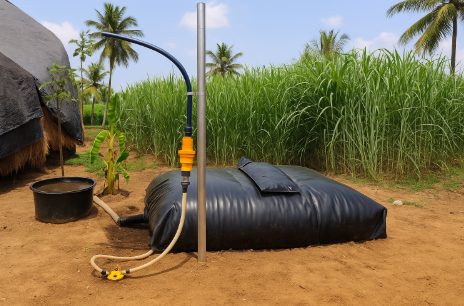Biogas and Bharat: Sistema.bio’s 100,000-Plant Milestone and the Dairy Sector’s Waste Revolution
By Dairy Dimension Analyst | 22 April 2025
In India’s fragmented but dynamic rural economy, clean energy often arrives not with headlines but with quiet, steady adoption. This month, Sistema.bio, a global social enterprise focused on small-scale biogas technology, announced the installation of its 100,000th biogas unit across 24 Indian states, impacting over 600,000 individuals.
While this is a headline-grabbing number, the real story lies in what it signals: a maturing convergence of dairy, energy, and sustainability—a sectoral shift that could redefine how India manages its 300 million-plus cattle and the waste they generate daily.
A Model Rooted in Manure, Powered by Partnerships
Since entering the Indian market in 2018, Sistema.bio has embedded itself in the dairy value chain through strategic partnerships with the National Dairy Development Board (NDDB), Infosys Foundation, and several large dairy cooperatives and companies. These alliances have enabled widespread deployment of compact, farmer-friendly digesters that turn cattle dung into methane-rich biogas and nutrient-dense slurry, transforming what is typically a rural waste challenge into a clean energy and organic input solution.
The company’s systems have treated millions of tons of organic waste while mitigating thousands of tonnes of CO₂-equivalent methane emissions—a crucial contribution in a country where livestock is the second-largest source of methane after rice cultivation.
Why Biogas Matters for the Rural Economy
India generates an estimated 3 million tonnes of cattle dung daily, with most of it either discarded, underutilised, or contributing to indoor air pollution when burned. Biogas plants help address four rural pain points simultaneously:
-
Energy Access & Cost Savings:
Households using biogas save approximately ₹4,000–₹6,000 annually on LPG or firewood. This is significant disposable income for a rural family earning ₹60,000–₹90,000 a year. -
Organic Fertiliser Supply:
Each biogas unit produces 2–3 tonnes of bio-slurry annually, reducing the dependency on chemical fertilisers. According to ICAR data, replacing synthetic urea with slurry can reduce fertiliser costs by 20–30% per acre. -
Women’s Health & Labour Burden:
Replacing smoky cookstoves with clean biogas reduces indoor air pollution exposure, contributing to over 480,000 premature deaths annually in India. Women and girls also save hours that would otherwise be spent collecting firewood. -
Climate and Waste Management:
India’s livestock sector emits over 5 million tonnes of methane annually. Each household biogas plant mitigates 1.5 to 3 tonnes of CO₂e/year, a small but scalable dent in national emissions.
A Dairy Opportunity, Not Just an Energy Solution
The implications for India’s dairy sector are profound. Manure management remains one of the least organised components of India’s otherwise vibrant dairy ecosystem. Biogas offers a way to close the nutrient loop and boost milk productivity by enabling cleaner sheds, healthier animals, and integrated organic fodder cultivation using bio-slurry.
Additionally, the rising global scrutiny on supply chain emissions and scope-3 carbon accounting means that Indian dairy exporters will soon need to prove their sustainability credentials. Biogas-based systems could be one of the few scalable solutions offering carbon-insetting opportunities for cooperatives and dairy companies.
Looking Ahead: Scaling Toward a Greener Bharat
Sistema.bio’s next ambition is bold: to empower 1 million farmers by 2030. If realised, this would represent one of the world’s most extensive decentralised biogas programs and position India as a dairy superpower and a leader in rural climate innovation.
However, scale will require alignment across policy, finance, and market incentives. While programs like SATAT (Sustainable Alternative Towards Affordable Transportation) have focused on large-scale biogas, the micro-scale sector lacks mainstream policy visibility. Bringing biogas into PM-KUSUM, FPO financing, or even carbon markets could be the push that transforms smallholder dairying into a net-positive climate contributor.
Atul Mittal, Director Business Devlopement SEA, share the milestone on Linkeidn.
